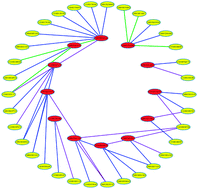A computational method for the identification of new candidate carcinogenic and non-carcinogenic chemicals†
Abstract
Cancer is one of the leading causes of human death. Based on current knowledge, one of the causes of cancer is exposure to toxic chemical compounds, including radioactive compounds, dioxin, and arsenic. The identification of new carcinogenic chemicals may warn us of potential danger and help to identify new ways to prevent cancer. In this study, a computational method was proposed to identify potential carcinogenic chemicals, as well as non-carcinogenic chemicals. According to the current validated carcinogenic and non-carcinogenic chemicals from the CPDB (Carcinogenic Potency Database), the candidate chemicals were searched in a weighted chemical network constructed according to chemical–chemical interactions. Then, the obtained candidate chemicals were further selected by a randomization test and information on chemical interactions and structures. The analyses identified several candidate carcinogenic chemicals, while those candidates identified as non-carcinogenic were supported by a literature search. In addition, several candidate carcinogenic/non-carcinogenic chemicals exhibit structural dissimilarity with validated carcinogenic/non-carcinogenic chemicals.


 Please wait while we load your content...
Please wait while we load your content...